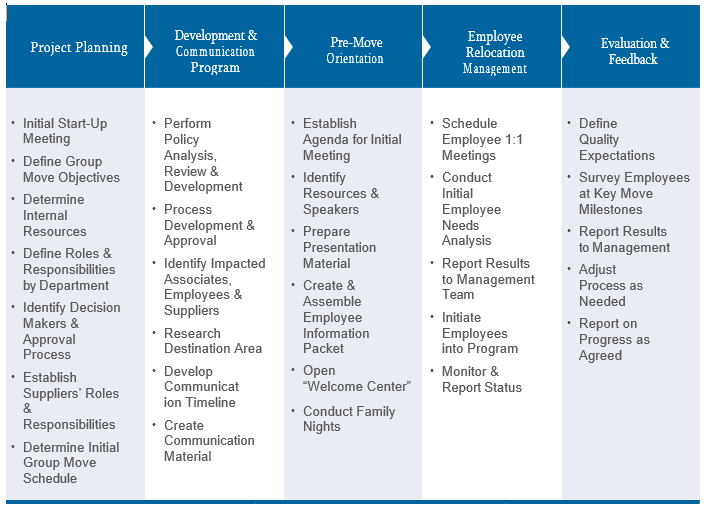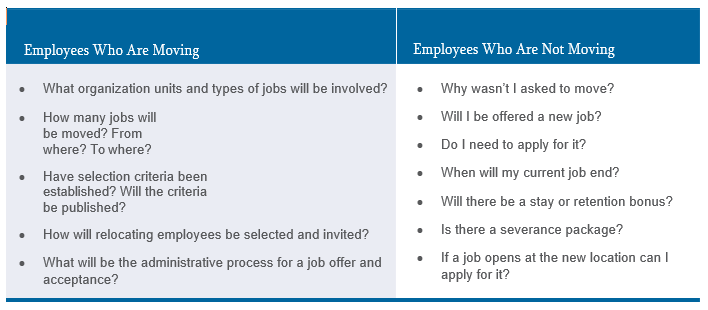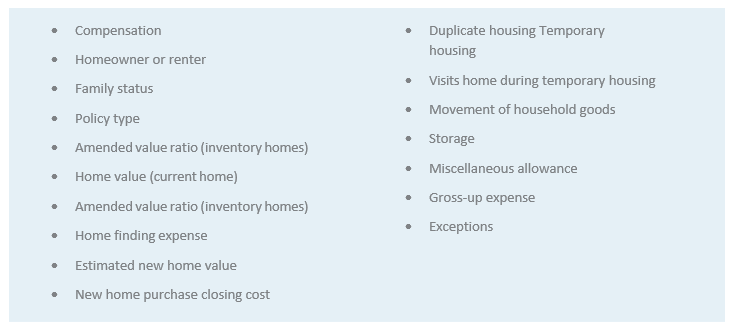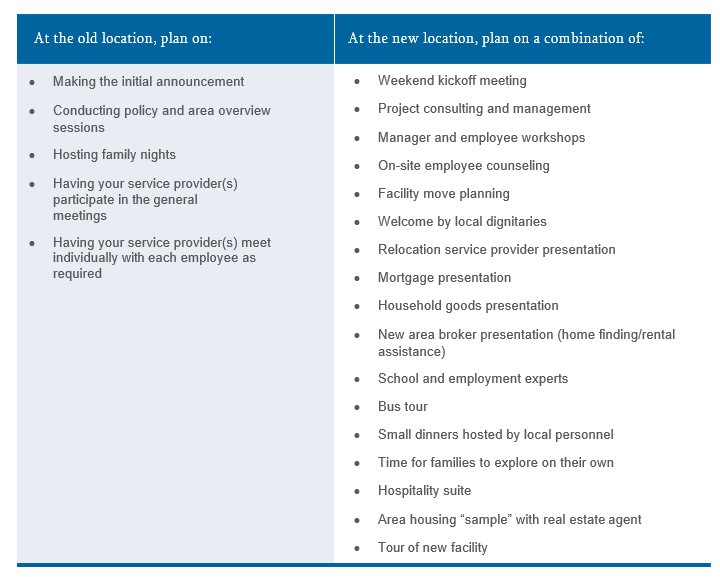
A Step-by-Step Guide for Planning a Group Move in 2020
Employee relocation is a crucial component for every growing company seeking to ensure that they are placing the right talent in the right location. Relocation helps firms leverage human capital, strengthen various business locations, incentivize
employees, and attract top talent. A unique facet of employee relocation is “group moves”. When a business needs to relocate ten or more employees from the same origin to the same destination location, this is considered a “group
move”. Businesses may need to plan a group move for a variety of reasons such as mergers and acquisitions, consolidating facilities, moving offices, adding new territories, and creating new lines of products. Group moves increase the scale
of a given relocation and as such, demand a higher level of planning to combat the increased complexity of moving many people at the same time. The context in which a group move is necessitated is also important and must be taken into account
during the planning phase as employees may feel worried about the impending changes, possibilities of job loss, or concerns about potentially moving to a new location which can result in lower morale and impact cooperation.
Challenges of Group Moves
Since the need to perform a group move often arises during major shifts in a business’s evolution, it’s important to be prepared for a variety of issues that may either be directly or tangentially related to the move itself. Some of these include:
- A disruption to business
- Losing talent
- Lower than usual team morale
- Budget overruns
There are also pitfalls that frequently occur in the planning of a group move itself. As you may imagine, organizing, preparing, and executing a relocation at the scale required by a group move is complex and leaves open the opportunity for mistakes and setbacks. The most common issues seen in the planning and execution of groups moves are:
- The move is announced too early and lacks the preparation or involvement necessary at that stage.
- Clear objectives have not been defined for the move.
- Not enough time or planning has been devoted to the move itself.
- Inability to organize all of the relocating employees.
- The needs and dynamics of the group of relocating employees has not been taken into account.
- Outside resources were needed earlier in the process.
- The use of non-qualified suppliers as a results of corporate leadership or political pressure.
- Not enough involvement from senior-level management.
Step by Step Best Practices for Planning a Group Move
By following these best practices, you can help to ensure that you avoid the above pitfalls and mitigate some of the challenges commonly encountered during the planning of a group move.
1. The Earlier the Better
Even if it seems you have a lot of time to plan a group move, do not put it off. Group moves have many moving parts. As such, delving in early ensures that you have a buffer to tackle unexpected issues that can arise throughout the planning process.
2. Hold off on Announcing
This may seem counter intuitive in that you may feel that it's best to give as much notice as possible. While it is true that you wouldn't want to spring a move on a group of employees too close to the intended move date, it is also true that an announcement opens up more questions than it answers. That is why much of the planning, in the beginning, needs to be focused around nailing down the very details the relocating employees would need to know before any announcements are made.
3. Think, Define, Explain
For those employees relocating, answers to the questions "where" and "why" should be fleshed out as early as possible. Be sure that you have a detailed explanation of the business decision behind the move and that it's clearly explained as to how this move will improve the company overall. Additionally, it is important to be transparent in the number of locations that have been considered prior to settling on the new location. Quality of life, cost of living, housing availability and other considerations need to be taken into account. Be sure to communicate what employees can expect in terms of these and other metrics.
4. Assemble a Team Within a Team
When it comes to group moves, it’s best to have two clearly defined teams. These two teams are often referred to as the “working team” and the “guidance review team”. Typically the working team is made up of the core team members who would be actively planning and working on the move itself day-to-day. Stakeholders such as the relocation manager, human resources, your relocation service provider, and finance typically fall under the “working team”. The “guidance review team” is usually comprised of payroll, accounting, IT, marketing, public relations, and managers who are not moving. Those in the “guidance review team” are stakeholders that do not need to be at every meeting but should be kept in the loop as action on their part may be needed throughout or at a later time in the move process. The “working team” is active throughout the move planning and execution process and needs to be at all meetings having to do with the move.
5. Create a Timeline & Project Plan
Once company leadership has provided your team with a hard date by which the move should be completed and your team has determined its feasibility, develop a timeline for the move. Your timeline should include five distinct phases: Project planning, development & communication program, pre-move orientation, employee relocation management, and evaluation & feedback. The items to be completed within each of these phases are detailed in the chart below.
Group Move Project Plan

6. Know Your People
Gathering data on the employees who will be impacted by the move is essential to analyzing how the move will impact the functions of the company. You will need more information on the people who will actually be moving versus those who will not. You should seek to collect information on the relocating employees such as their current and new position, tenure, current and new salary, current and new manager, family information, whether they own or rent their home, current address, and expected move date.
7. Have All the Answers
As you may expect, there will be a lot of questions coming from both the employees who are asked to relocate and those who are not. Make sure before you announce the move that you have the answers to the following questions at the ready.
Questions That Need to be Answered

8. Get Familiar With Your Relocation Policy
Your company’s relocation policy may or may not serve the needs of your group move. This is the time to review the details of your current relocation policy to determine which if any changes or additions need to be made to support the needs of your group. Many of these considerations will be dependent on the types of locations involved in the group move. For example, if the group of employees is moving from a small town and many will be selling their homes, will there be protection provided for the potential lower value on their homes as a result of the uptick in inventory due to the group move? Additionally, will you require more temporary housing coverage or an added benefit to act as an incentive for the employees to make the move? These and other questions like them must be considered to ensure that your relocation policy is able to meet your company’s needs during this larger scale relocation.
9. Gather Data
You will want to collect data from both the employees themselves and on the current and new locations. Survey your employees to understand what they feel they need in a relocation policy to support their proceeding with the move. In creating the survey questions, be sure to already be well acquainted with what benefits or exceptions that will absolutely not be approved to avoid including questions having to do with them. This is also a good time to see where potential benefits trading may apply and where your company feels comfortable being flexible. Cases such as applying childcare coverage to the cost of children going on a home-finding trip and other related benefits ought to be considered. For location data, whether performed in-house or by an outside firm, arrange a market study of both the old and new locations. Market studies will help your team determine the cost and availability of housing so that you are able to estimate real estate commissions, reimbursement of closing costs, and other location-dependent line items that will impact budget and cost overruns.
10. Preliminary Budgeting
Group move costs can create spikes in company expenditures; that is why creating a preliminary budget is essential. Once you have determined the amount that must be allocated to complete the group move, ensure you also understand how the projections were developed and under what assumptions. Then set to calculating your line item amounts while also indicating when these costs are likely to be incurred. Many costs involved in relocation occur at different times; this is especially true when home sale programs are involved. Below are some of the typical line items that ought to be included in the preliminary budget for your group move.

Importantly, a separate budget that includes the costs of tours, special events, additional travel, severance, and retention bonuses should be maintained as well.
11. Solidify Your Relocation Policy with Management
Now that you know what employees will require in order to make the move, what changes need to be made to your current relocation policy, expected costs, and unique market considerations, it’s time to finalize your relocation policy with management. Compile a presentation that includes the benefits you recommend offering along with the supporting rationale for their inclusion. Be sure to use cost ranges over a set amount for the numbers as these may change depending on exceptions made and unforeseen changes during the actual move.
12. Create a Communication Plan and Announce the Move
Determine what information materials will need to be supplied to employees for the announcement and create an informational packet along with an FAQ sheet to handout. Make arrangements for the announcement including finding space, arranging food, compiling handouts, and planning the agenda for the day. Also be sure that whoever is leading the announcements is clear on what they should say, how to answer likely questions, and not to over promise. Some important items to include in the materials given to employees are an agenda, schedule of events, copy of the announcement, material on the new location, highlights of the relocation policy and the policy itself, policy for travel and expense reimbursement, key contact information, and the FAQ sheet.
Once employees have been informed of the move, the announcement has been made, and most questions have been answered, a decision period is given to the employees. Oftentimes, these are very short, with many companies giving employees 48 hours to decide whether or not they will commit to the move. Make sure that you provide relocating employees with as much support as possible including informative links to helpful websites, times for additional questions to be answered, and access to a relocation center or resource room. Some companies also provide a toll-free number employees can call to receive pre- decision counseling. Informational and evaluation activities should be planned in advance at both the old location and new location to make for a smooth transition and well-adjusted employees. On the next page there’s a helpful chart outlining some of the activities you should consider planning and at which location they are most suitable.

There is no question that a lot of work goes into planning a group move. That is why it is helpful to have a trusted relocation provider to turn to. It is important to get clear on what your relocation provider offers in terms of support to evaluate what may be best handled by their team of professionals in order to free up your team to focus on other aspects of the move. Professional relocation providers offer an array of services that can be added to make the planning of your group move go more smoothly. Some of these helpful services include relocation cost analysis, policy design, employee presentations, preparing relocation resource centers, creating information kits, area tours, and others. Want to learn what to expect after the planning process of a group move, including how to best manage the move itself? Read our blog post, “5 Essential Keys To Managing A Group Move.”
For help with an upcoming group move or your broader relocation policy, contact Bobbi Maniglia,
VP of Corporate Sales and Moving Services for northAmerican® Van Lines at Bobbi.Maniglia@northamerican.com.
Click Download Now to download the guide.
Keep up to date on the latest news, industry trends and research regarding domestic and global employee moving and relocation, and commercial moving.
SUBSCRIBE TODAY!
Contact our moving experts now and get started.

